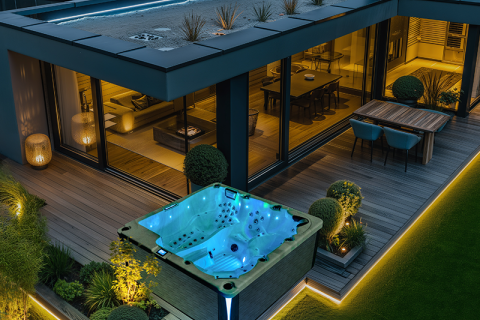
- Home
- >
News
People who are not suitable for outdoor hot tubs: 1. People with cardiovascular diseases 2. People with respiratory diseases 3. People with diabetes 4. Pregnant women 5. People with sensitive skin or skin diseases 6. People with poor body temperature regulation 7. Alcoholics and drug users 8. People with weak immune systems 9. People who are overly tired or dehydrated
Common home hot tubs are usually equipped with 3kW to 5kW heaters. For example, a 3kW heater can heat about 2°C to 3°C per hour. If you want to heat from 15°C to 40°C, it theoretically takes about 8 hours. In contrast, if it is a 5kW heater, the time required may be shortened to about 5 hours.
Diseases that can be spread in hot tubs: 1. Legionnaires' disease (causing severe pneumonia), 2. Pseudomonas infection (ear, urinary tract infection), 3. Skin fungal infection (skin itching, erythema), 4. Norovirus infection (diarrhea, vomiting, fever), 5. Mold infection (cough, nasal congestion).
A hot environment causes the body to expend more energy to maintain internal temperature balance and stimulates the activity of the sympathetic nervous system. Increased activity of the sympathetic nervous system leads to increased adrenaline secretion, faster heartbeat, and possibly higher breathing rate.
Steps to install a hot tub in the garden: 1. Preparation for installing a hot tub: ● Determine the installation location: ● Prepare infrastructure: ● Prepare electricity and water sources: 2. Steps for installing a hot tub ● Foundation preparation: ● Install electricity and water sources: ● Placement of the hot tub: ● Connect water and electricity equipment: ● Filling and debugging: 3. Precautions for installing a hot tub ● Safety considerations: ● Maintenance and care:
First, pour antifreeze into the nozzles and pipe system. These parts are most likely to freeze, so you need to ensure that the antifreeze can be fully covered. You can use a funnel to pour the antifreeze into the nozzle mouth and start the nozzle for a few seconds to ensure that the antifreeze enters the pipe.
Acrylic is a plastic with high transparency, good gloss and strong toughness, which is widely used in the manufacture of hot tub shells and bottoms. Its surface is smooth and easy to clean and maintain.
The high temperature environment of a hot tub can dilate blood vessels and increase blood flow. Good blood circulation helps to transport oxygen and nutrients to cells throughout the body, promote metabolism and cell repair. This is helpful for delaying aging.
In a hot tub without a filter, the water quality will deteriorate rapidly. Impurities and dirt cannot be effectively removed, and suspended particles, bacteria, and algae in the water will increase rapidly.
For people who are in good health and have no obvious health problems, it is recommended to soak in a 104°F (40°C) hot tub for 10 to 15 minutes. This time is enough to enjoy the relaxing and soothing effects of a hot tub while avoiding the adverse effects of soaking for a long time.
The quietest hot tub brands and their noise levels: 1. Caldera Spas® (usually between 40-45 dB) 2. Hot Spring Spas® (usually between 38-42 dB) 3. Jacuzzi® (usually between 40-44 dB) 4. Sundance Spas® (about 40-43 dB)
10 Problems Solving Hot Tub Operation 1. Spa Not Operating 2. Spa Not Heating Even When Jets and Lights Are Operating 3. Jets Operating Weakly or Surge 4. Light Not Working 5. Jets Not Operating or erratic 6. Blue Logo "Power" Light Flashing 7. Green Logo "Ready" Light Flashing...












